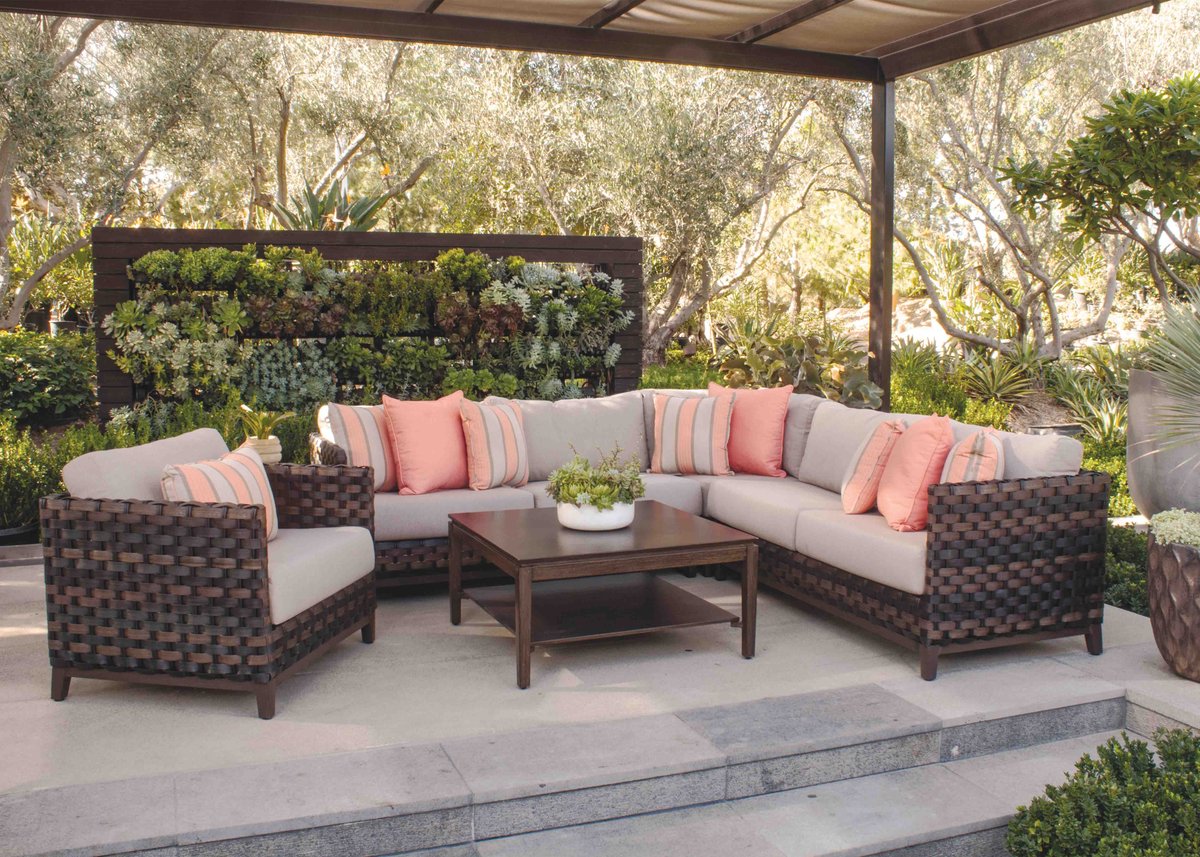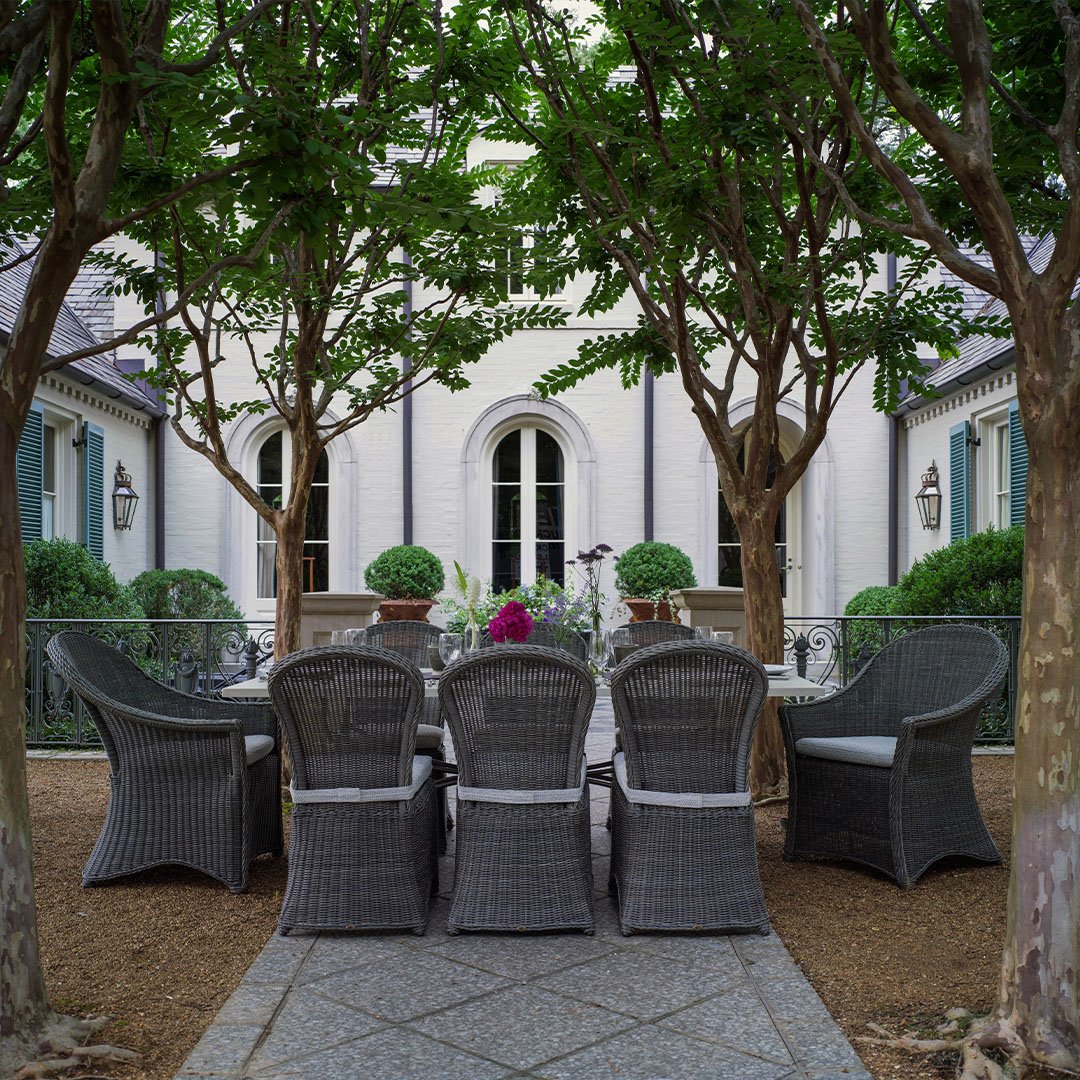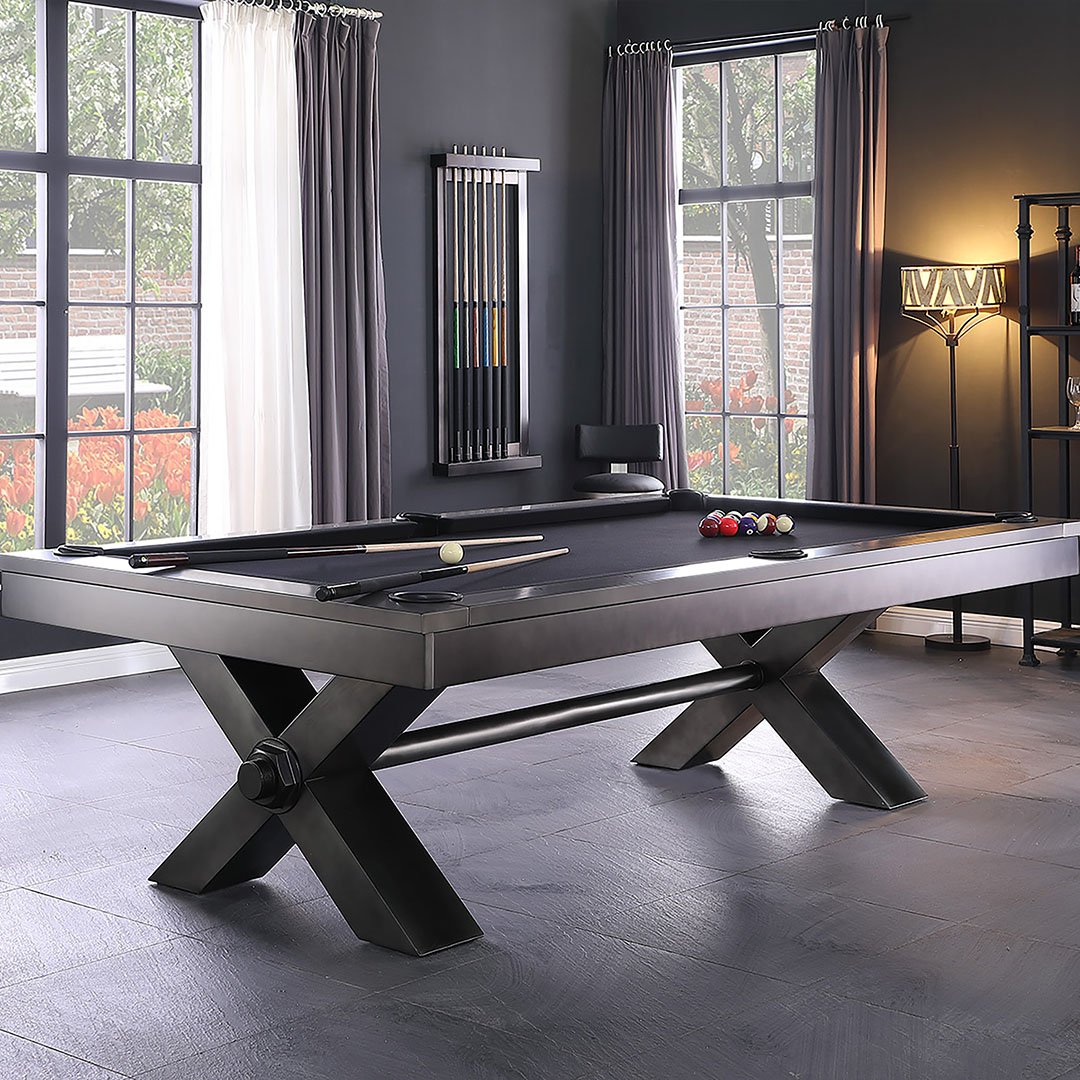Harmony in Design: Outdoor Furniture and Plant Pairings
Your outdoor space is an extension of your home, and you want to create a design that is both functional and aesthetically pleasing. One way to achieve this is to carefully consider the pairing of your outdoor furniture and plants. By choosing pieces that complement each other in terms of color, texture, and size, you can create a space that is both inviting and stylish.
So whether you're looking to update your current outdoor furniture or start from scratch, keep reading for some inspiration.
Understanding Harmony in Outdoor Design
Before we dive into garden color schemes, furniture, and other key elements of creating an attractive outdoor space, it's important that we understand the basics of harmony in outdoor design.
The Concept of Harmony in Design
Harmony in design refers to the seamless integration of different elements to create a visually pleasing and balanced environment. It involves carefully selecting and combining various components, such as outdoor furniture and plants, to achieve a cohesive and harmonious look.
The Importance of Harmony in Outdoor Spaces
Harmony plays a crucial role in outdoor spaces as it enhances the overall aesthetic appeal and contributes to the creation of a welcoming and relaxing atmosphere. A harmonious garden landscape design can create a visual sense of order and unity, making it more enjoyable for homeowners and visitors alike.
Creating Harmony with Outdoor Furniture
Now that we know what harmony means in outdoor design, you might be wondering how exactly you can achieve harmony in your backyard or patio. With a little strategy, creating harmony with outdoor furniture can be simple.
Choosing the Right Furniture for Your Outdoor Space
The first step in creating harmony is to choose outdoor furniture that fits well with your overall garden color scheme. Consider the style and theme of your garden or patio and select furniture that complements it. For example, if you have a modern garden, opt for sleek and minimalist furniture that will blend seamlessly into the surroundings. On the other hand, if you have a more traditional outdoor space choose furniture with intricate and classic designs.
Functionality is another key factor to consider. Outdoor furniture should not only be visually appealing but also practical. Think about how you will be using your outdoor space. If you often host gatherings, opt for furniture with ample seating and sturdy construction. If you prefer more intimate settings, consider cozy lounge chairs or a hammock for relaxation. Balancing function and aesthetics will help you create a space that is both beautiful and comfortable.
Don't be afraid to mix and match different furniture pieces. Combining different materials, such as wood and metal, can add visual interest and create a dynamic look. Just make sure the materials harmonize well with each other and the surrounding plants. Additionally, consider the size and scale of your outdoor space before purchasing furniture. Oversized pieces can overpower a small garden, while too many small pieces can create a cluttered look.
Check out Watson's selection of outdoor furniture and accessories!
Using Colors and Materials to Create Harmony
A well-thought-out color scheme is crucial in creating perfect harmony between your outdoor furniture and plants. Look at a color wheel to find complementary colors that work well together. For example, pairing a blue outdoor furniture set with orange flowers can create a striking and eye-catching combination. Alternatively, go for analogous colors, which are next to each other on the color wheel, for a more subtle and soothing palette.
Consider the materials used in both your furniture and plants. Green foliage can act as a neutral backdrop and complement the furniture in various colors. If you have furniture in darker colors, such as black or deep brown, consider incorporating plants with lighter leaves to create contrast. On the other hand, if your furniture has a lighter color palette, plants with vibrant and bold-colored blooms can add a pop of color to your outdoor space.
Another way to create harmony is by using companion plants to enhance the overall aesthetics of your outdoor space. Choose plants that complement your furniture in terms of color, texture, and height. For example, if you have a wooden patio set, consider adding ground cover with delicate flowers or tall plants with a cascading effect to create a lush and inviting atmosphere.
If you're interested in learning some other ways to create the perfect outdoor space, check out our guide on outdoor space design strategies.
Incorporating Plant Pairings in Your Design
When it comes to designing your outdoor space, there are many factors to consider. By carefully choosing your plants and pairing them with the right furniture, you can create a visually appealing and cohesive design.
The Role of Plants in Achieving Harmony
Plants play a crucial role in achieving harmony in your garden landscape design. They provide a natural, organic element that softens the hard lines of furniture and structures. Plants can also add pops of color and texture to your outdoor space, creating a visually pleasing environment.
When it comes to selecting plants for your outdoor area, think of color first. A well-chosen botanical garden color scheme can help create a cohesive and harmonious design.
Another important factor to consider is the amount of sunlight your outdoor space receives. Different plants have different light requirements, so it's important to choose plants that will thrive in the amount of sunlight available. Full-sun plants, for example, require at least six hours of direct sunlight a day, while shade-loving plants prefer indirect or filtered sunlight.
Selecting the Right Plants for Your Outdoor Space
Before selecting plants for your outdoor space, you should consider the specific conditions of your garden. Factors such as soil type, climate, and maintenance requirements should all be taken into account.
Companion plants are a great way to enhance the beauty of your outdoor space. These are plants that grow well together and offer multiple benefits. For example, pairing tall plants with ground cover can create a stunning layered effect. The taller plants provide structure and vertical interest, while the ground cover fills in the spaces and adds a touch of color. This combination can create a visually appealing and low-maintenance garden.
When selecting plants, it's also important to consider their growth habits. Some plants spread rapidly and can become invasive, while others are slow-growing. Knowing how a plant will grow and spread over time can help you plan and maintain a harmonious garden.
Pairing Plants with Furniture for a Harmonious Design
Now that you have an understanding of the role plants play in achieving harmony and how to select the right plants for your outdoor space, let's explore how to pair plants with furniture for a harmonious design.
As previously mentioned, think of how the color of your furniture will play with the color of your plants first. If you have dark-colored furniture, pairing it with plants that have vibrant and contrasting colors can create an eye-catching display. On the other hand, if your furniture is light-colored, opting for plants with more subdued and complementary colors can create a calming and cohesive look.
In addition to color, you should also consider the foliage of the plants. Green foliage is always a classic choice and pairs well with most furniture colors. However, if you want to make a statement, consider incorporating plants with variegated or colorful foliage. This can add visual interest and create a dynamic look in your outdoor space.

Recognizing and Avoiding Design Pitfalls
Creating a beautiful and harmonious outdoor space can be both exciting and challenging. When designing your outdoor area, it's important to be aware of common design pitfalls that can disrupt the overall harmony and aesthetics. By recognizing and avoiding these pitfalls, you can ensure that your outdoor design is visually appealing and well-balanced.
Common Mistakes in Outdoor Design and How to Avoid Them
Ignoring the color scheme
A common mistake in outdoor design is neglecting to establish a cohesive color scheme. Your outdoor space should reflect your personal style and preferences while maintaining a harmonious balance. To avoid this pitfall, select a color scheme that complements your home's exterior and the surrounding landscape. You can use the color wheel as a guide to create a harmonious combination of colors.
For example, if your home has a neutral color palette, you can opt for a complementary color scheme by pairing warm earth tones with cool blues or greens. This will create a visually pleasing and balanced outdoor design.
Failing to consider companion plants
Companion plants play a crucial role in maintaining harmony in outdoor design. They can enhance the overall aesthetics and provide a natural backdrop for your outdoor furniture. When selecting companion plants, consider their height, texture, and color. Choose plants that complement the style and color scheme of your outdoor furniture.
For instance, if you have modern furniture with clean lines and minimalist design, you can pair it with companion plants that have lush green foliage and simple, elegant blooms. This combination will create a cohesive and visually appealing outdoor space.
Neglecting the garden landscape design
A well-designed garden landscape can greatly contribute to the overall harmony of your outdoor space. Ignoring the garden landscape design can result in a disjointed and visually overwhelming outdoor area. To avoid this pitfall, consult with a professional landscape designer or do thorough research on garden design principles.
Consider the layout of your outdoor space, the topography of your yard, and the specific needs of the plants you choose. Create a plan that includes pathways, focal points, and areas for relaxation. This will ensure that your outdoor design is cohesive and visually pleasing.
Maintaining Harmony in Your Outdoor Design over Time
Keeping your outdoor design harmonious and visually appealing requires ongoing maintenance and care. Here are some tips to help you preserve the harmony in your outdoor space:
- Regularly trim and prune plants to maintain their shape and prevent overgrowth. This will ensure that they complement the overall design and don't overshadow the furniture or other elements in your outdoor space.
- Consider the changing seasons and how they can affect the overall aesthetics of your outdoor area. For example, if you have deciduous trees or shrubs that lose their leaves in the fall, consider incorporating evergreen plants or installing additional outdoor lighting to maintain visual interest during the winter months.
- Keep an eye out for any signs of wear and tear on your outdoor furniture. Replace worn-out cushions, repaint or refinish furniture if needed, and regularly clean and maintain all furniture pieces to ensure they continue to enhance the overall design and remain in good condition.
Remember, outdoor design is not a one-time project; it requires ongoing attention and care to maintain its harmony and appeal. By avoiding common mistakes and regularly maintaining your outdoor space, you can enjoy a visually pleasing and well-balanced outdoor area for years to come.
Uncover Our Versatile Outdoor Furniture Sets
If you’re interested in finding new outdoor furniture, Watson’s has everything you need.
When you shop with us, you’ll find an amazing selection and personalized service, along with the guaranteed lowest prices in the USA. We have a wide variety of outdoor furniture from the leading brands along with tons of accessories to make your outdoor space complete. Shop online or stop by your nearest Watson’s location today.

FAQs
What is the principle of harmony in landscaping?
The principle of harmony in landscaping refers to the way different elements are combined and arranged to create a visually pleasing and balanced design. It involves the careful selection and arrangement of plants, colors, textures, and other features to create a coherent and unified overall picture. The goal is to create a sense of unity and balance, where each element complements and enhances the others, creating a harmonious and inviting outdoor space.
What is the best color for outdoor furniture?
The best color for outdoor furniture ultimately depends on personal preference and the desired aesthetic of the outdoor space. However, it's generally recommended to choose neutral colors such as white, gray, or beige as they tend to blend well with the surrounding environment and can easily be paired with different accent colors.
What color is not recommended for outdoor furniture?
While there is no hard and fast rule, it's generally not recommended to choose light or pale colors for outdoor furniture. Light colors like white or pastels tend to show stains and dirt more easily, making them difficult to maintain and keep clean. In addition, light-colored furniture may fade and discolor when exposed to prolonged sunlight. It is generally safer to opt for darker colors that are more forgiving in terms of stains and fading and can provide better longevity and visual appeal for outdoor furniture.












